I've just added a fantastic link to our "the links we can link" section of the sidebar - Bird-Safe Buildings by Project BirdSafe of MN Audubon.
There's a pdf on the site that is absolutely fantastic and I'd love to see it incorporated in references for architecture, urban planning, landscape design, biology, etc. It is relevant to all of the above. Maybe even astronomy, due to the light pollution factors!
To download the pdf, click here. It's the best 3.7 MB you'll download this year.
As for the 'bis spaeter' portion of the title - on Friday, we are heading out towards Fort Stockton, where we'll be for the next three months. Here's a little snippet of what we'll be involved in - Aplomado Falcon Update via The Peregrine Fund. Hopefully we'll be able to update the blog on occasion, but if not, the abundance of posts this month will hopefully make up for it!
28 June 2010
25 June 2010
the return
As we pack up to leave for west Texas again, here's the last batch of photos from a month ago:

The horizon looks benign until you notice a creeping plague of wind farms...

These areas are poorly studied for overall impact - what we do know about migration would suggest that these dry areas really aren't bird-dense. That does not stop local and migrating birds from being killed, though. We don't really even understand anything about bat migration at this point, so pushing wind farm development without knowing the basic life histories of the critters impacted is a very ill planned scheme. For all of the screaming for "green" energy, very few people are willing to unplug their own habits.
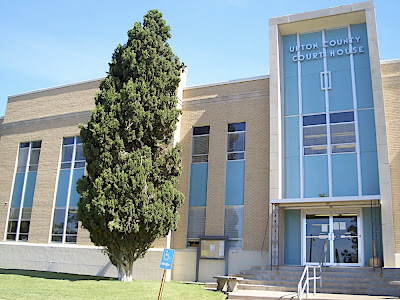
Matt and I added another pile of counties to our ever-growing county courthouse list. Texas has something like 257 counties and we are trying to visit every single one* (except for those in major urban centers, because those are no fun). Upton County's courthouse matched the earth and the sky, and was perched atop a lovely hill.
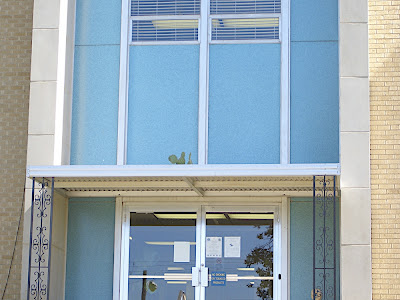
The design of the building didn't interest Matt too much, though we did have a good chuckle over the cactus growing on the awning over the front door! What struck me about this building is the use of bright colors. They appear to be opaque panels, but window film can certainly be modified in a manner that would make a glass box look identical to this building; it might be a bit extreme to print faux bricks on the film, but you can minimize the reflective surfaces and space them out in ways that would be less susceptible to bird strikes.
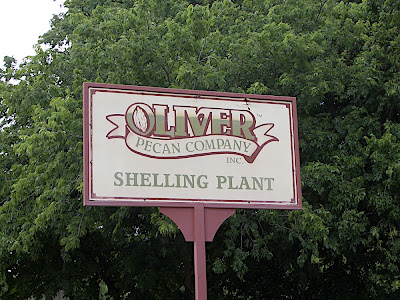
For the nephew: there are a ton of "Oliver's" signs in San Saba, TX - and they're not just into pecans! Quite a few signs are for pecan related things though, so we snuck a picture before returning to Waco.
The horizon looks benign until you notice a creeping plague of wind farms...
These areas are poorly studied for overall impact - what we do know about migration would suggest that these dry areas really aren't bird-dense. That does not stop local and migrating birds from being killed, though. We don't really even understand anything about bat migration at this point, so pushing wind farm development without knowing the basic life histories of the critters impacted is a very ill planned scheme. For all of the screaming for "green" energy, very few people are willing to unplug their own habits.
Matt and I added another pile of counties to our ever-growing county courthouse list. Texas has something like 257 counties and we are trying to visit every single one* (except for those in major urban centers, because those are no fun). Upton County's courthouse matched the earth and the sky, and was perched atop a lovely hill.
The design of the building didn't interest Matt too much, though we did have a good chuckle over the cactus growing on the awning over the front door! What struck me about this building is the use of bright colors. They appear to be opaque panels, but window film can certainly be modified in a manner that would make a glass box look identical to this building; it might be a bit extreme to print faux bricks on the film, but you can minimize the reflective surfaces and space them out in ways that would be less susceptible to bird strikes.
For the nephew: there are a ton of "Oliver's" signs in San Saba, TX - and they're not just into pecans! Quite a few signs are for pecan related things though, so we snuck a picture before returning to Waco.
24 June 2010
Shirt skirt - original
These photos were piled up from June 2010, but there was no post! Trying to reference this design (which now exists in a longer, swirly teal color as well) was hard without pictures, so here goes a backdated post:
Ingredients -
1 shirt that isn't too tight for your bum
1 drawstring

Step one:
Cut off sleeves

Step 2:
Chop neckline on front and back

Step 3:
Cut sleeve seam
Step 4:
Turn skirt sideways and fit sleeve
cuttings into skirt gap (they will be
upside down from their original
configuration!)
Step 5:
Add drawstring
Final product: shittacular photo of shirt skirt.

Ingredients -
1 shirt that isn't too tight for your bum
1 drawstring

Step one:
Cut off sleeves

Step 2:
Chop neckline on front and back

Step 3:
Cut sleeve seam
Step 4:
Turn skirt sideways and fit sleeve
cuttings into skirt gap (they will be
upside down from their original
configuration!)
Step 5:
Add drawstring
Final product: shittacular photo of shirt skirt.

Terlingua nights
It's a quiet, peaceful feeling when you watch Mexico slip into a shroud of darkness on the horizon. Stars are peeking out while there's still plenty of glow. So to watch the light change in waves across the sky, while watching the land itself filter through different glows... there's a little slice of heaven that no city can capture.
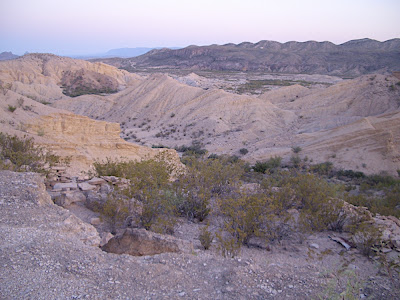
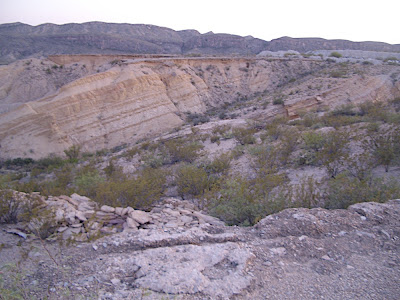

Matt looking out towards Mexico.
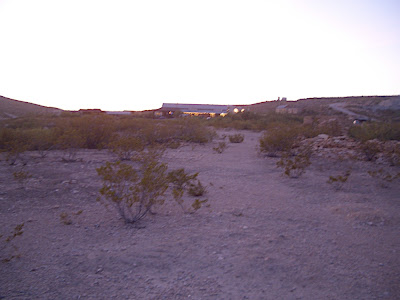
The trading post.

A speck?
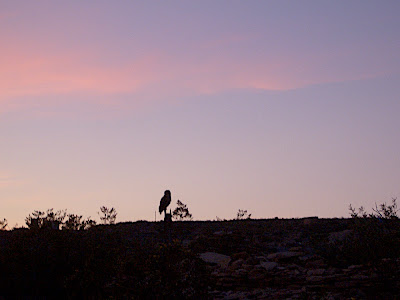
A big speck!
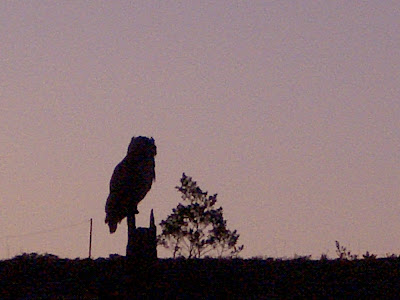
A very large, young Great-Horned Owl (Bubo virginianus). Looks like it is sitting on Batman's head, no?

Overlooking the ghost town.
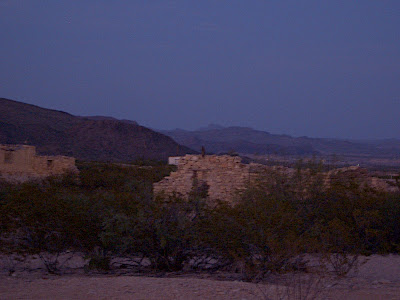
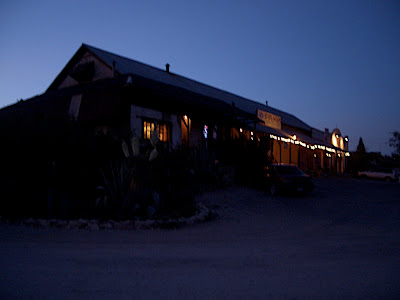
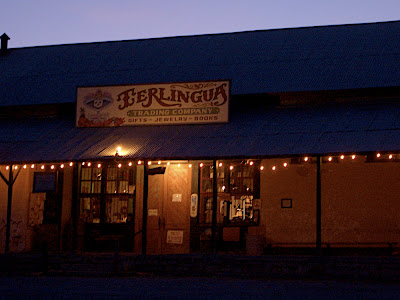
The store, all lit up.
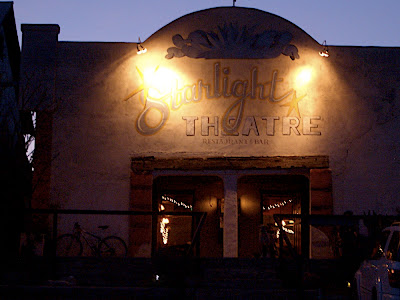
The Starlight...

Matt looking out towards Mexico.
The trading post.

A speck?
A big speck!
A very large, young Great-Horned Owl (Bubo virginianus). Looks like it is sitting on Batman's head, no?
Overlooking the ghost town.
The store, all lit up.
The Starlight...
22 June 2010
back when Lajitas was Lajitas
Alternate post title: la cabra que se encanta cervezas.
Lajitas used to be a dusty little town near Terlingua. Now it's a strange little golf resort that somehow has more water use priority than some farmers down river. That discussion is for another day. You may guess where my loyalty lies.
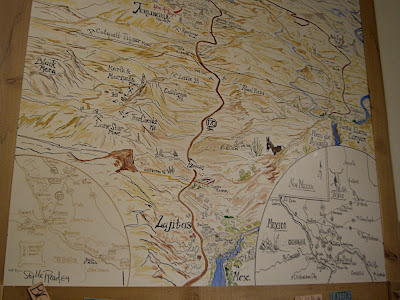
This fancy local map shows the area pretty nicely - it's up on the wall at the trading post.
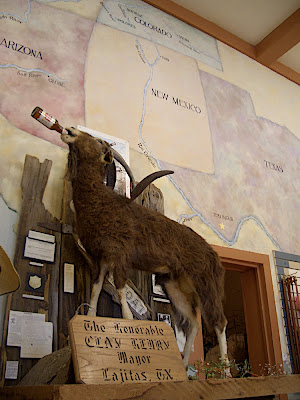
The Honorable Clay Henry, Mayor of Lajitas, Texas.
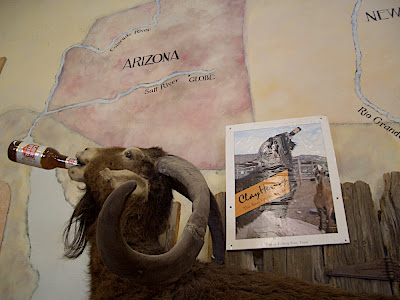
To my understanding, an out-of-towner had been voted mayor and there was quite a bit of dissent over that. Enter Clay Henry, the goat whose beer of preference was Lone Star - apparently he wouldn't drink any other brand.

The trading post has quite a bit of memorabilia, and serves as the final resting place (if you can call it that) for the mayor.
My feeble tribute doesn't quite do this legend justice - but check out this page, and this NY Times story.
Lajitas used to be a dusty little town near Terlingua. Now it's a strange little golf resort that somehow has more water use priority than some farmers down river. That discussion is for another day. You may guess where my loyalty lies.
This fancy local map shows the area pretty nicely - it's up on the wall at the trading post.
The Honorable Clay Henry, Mayor of Lajitas, Texas.
To my understanding, an out-of-towner had been voted mayor and there was quite a bit of dissent over that. Enter Clay Henry, the goat whose beer of preference was Lone Star - apparently he wouldn't drink any other brand.
The trading post has quite a bit of memorabilia, and serves as the final resting place (if you can call it that) for the mayor.
My feeble tribute doesn't quite do this legend justice - but check out this page, and this NY Times story.
creatures of Terlingua
This is by no means a comprehensive guide to the critters of Terlingua, but it highlights a few novel things:
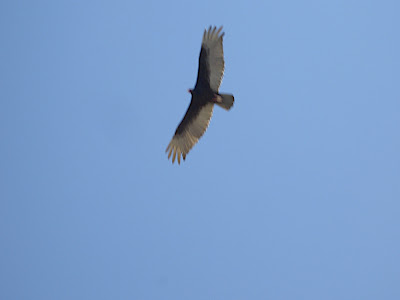
The ubiquitous Turkey Vulture (Cathartes aura).

We didn't see any javelinas (collared peccary), nor were we particularly concerned - they're docile. Feral hogs are more vicious by far. But we were quite tempted to get the t-shirt. It at least inspires hikers to leave the wildlife alone!
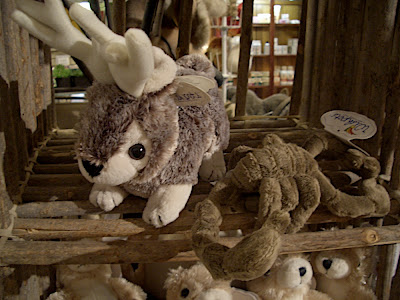
Stuffed jackalope! I've never seen a plush jackalope - taxidermy may be pretty advanced on matters of the jackalope, but there's nothing quite seeing your beloved jackalope immortalized in a line of plush creatures. The scorpion still rocks, almost as much as the plush rattlesnake I'm so fond of.

When I saw this, I did a double-take. Many birds have been plush-ized, and many are kind of strange (the blue TY pelican comes to mind), but this was the first time I've ever seen a plush Aplomado Falcon (Falco femoralis).

...see? Even the tag says so! And what interesting timing.
The ubiquitous Turkey Vulture (Cathartes aura).

We didn't see any javelinas (collared peccary), nor were we particularly concerned - they're docile. Feral hogs are more vicious by far. But we were quite tempted to get the t-shirt. It at least inspires hikers to leave the wildlife alone!
Stuffed jackalope! I've never seen a plush jackalope - taxidermy may be pretty advanced on matters of the jackalope, but there's nothing quite seeing your beloved jackalope immortalized in a line of plush creatures. The scorpion still rocks, almost as much as the plush rattlesnake I'm so fond of.

When I saw this, I did a double-take. Many birds have been plush-ized, and many are kind of strange (the blue TY pelican comes to mind), but this was the first time I've ever seen a plush Aplomado Falcon (Falco femoralis).
...see? Even the tag says so! And what interesting timing.
21 June 2010
modern Terlingua
Out by the highway there's an odd combination of RV plus... whatever this collection of strange things is.
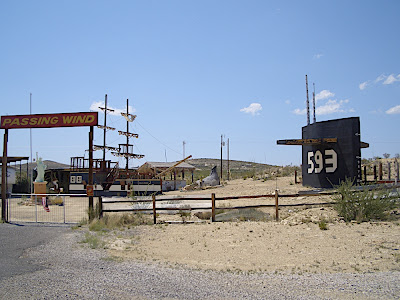
From L to R: covered RV, Lady Liberty, a tallship, some sort of submarine mock-up? There's other stuff tucked away back there, not really sure we want to know what all there is!
Up in what's now the hub of Terlingua:
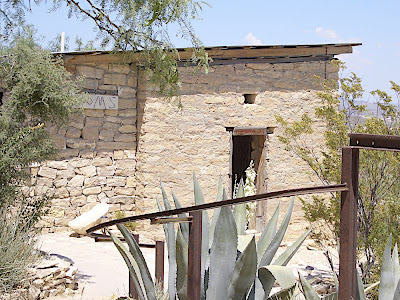
Bathrooms, pleasantly housed in original buildings, but rather dark inside. Running water and ornate tiles were pretty neat for such rustic outside appearances.
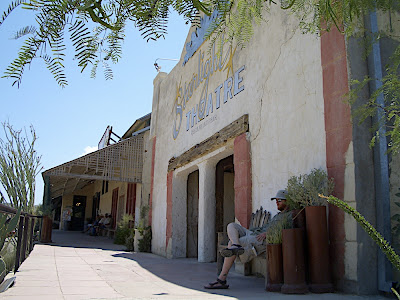
The old Starlight Theater, now a restaurant and bar featuring live music on most nights. The music is generally one fellow with a guitar and a pile of songs up his sleeve. Also a pile of CDs if you're interested.

The back of the theater has a large mural; mood lighting is strings of Christmas lights.
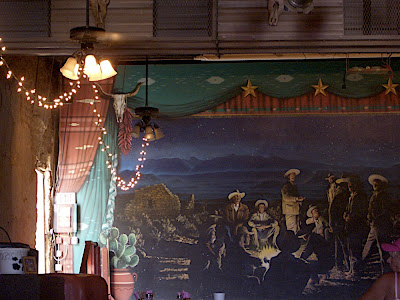
The back door was propped open for ventilation.
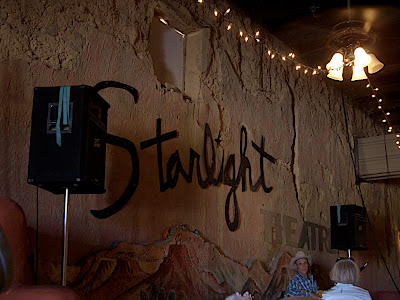
Did we mention a fellow with a guitar? And that the old theater walls have a lot of character? It's really quite lovely to see the layers of history.

My bowl of chili was delicious. The balance of spice and heat was perfect, medium and flavorful. I wish I'd taken a photo of our table before the food came - each of the tables was painted by a local artist and then varnished. Our particular table was pale yellow with long, outward stretching ocotillo branches from the center of the table... and koi swimming around their shadows. It was a fantastic combination of bright desert colors being shown as aquatic vegetation. My inner art student was thrilled!
From L to R: covered RV, Lady Liberty, a tallship, some sort of submarine mock-up? There's other stuff tucked away back there, not really sure we want to know what all there is!
Up in what's now the hub of Terlingua:
Bathrooms, pleasantly housed in original buildings, but rather dark inside. Running water and ornate tiles were pretty neat for such rustic outside appearances.
The old Starlight Theater, now a restaurant and bar featuring live music on most nights. The music is generally one fellow with a guitar and a pile of songs up his sleeve. Also a pile of CDs if you're interested.

The back of the theater has a large mural; mood lighting is strings of Christmas lights.
The back door was propped open for ventilation.
Did we mention a fellow with a guitar? And that the old theater walls have a lot of character? It's really quite lovely to see the layers of history.
My bowl of chili was delicious. The balance of spice and heat was perfect, medium and flavorful. I wish I'd taken a photo of our table before the food came - each of the tables was painted by a local artist and then varnished. Our particular table was pale yellow with long, outward stretching ocotillo branches from the center of the table... and koi swimming around their shadows. It was a fantastic combination of bright desert colors being shown as aquatic vegetation. My inner art student was thrilled!
20 June 2010
Terlingua, part2
The earlier photos show the larger buildings, but most of the remains are of much smaller size. Some are nothing but a pile of rubble, others have fragments of wall remaining. Most were simple one room huts, few are still being lived in today.
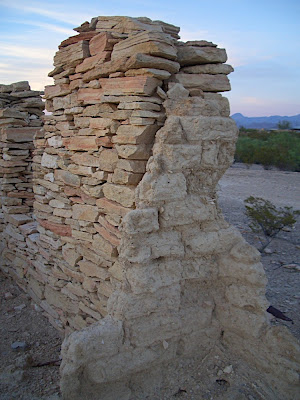
What's so great about the ruins is that you can see what different construction techniques were used. Above, the front blocks are a mixture of clay/dirt/hay bricks and they're clearly mortared with what looks like a similar mix. The wall behind it consists of stacked rocks. They're thin, flat pieces, so they're pretty stable. But there's no mortar. I'll try not to think of the number of spiders living in them...
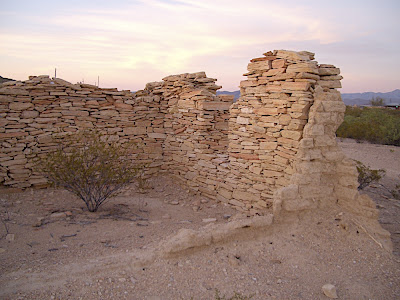
Time has worn away the bricks, a shrub now inhabits an old room. The stacked walls remain.
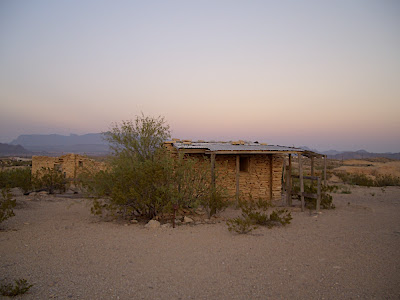
One small building looked like it was still viable, so we investigated.
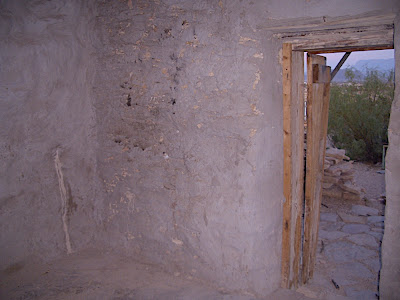
The walls on either side of the door were lightly mortared with concrete, but the process had been abandoned before completion.
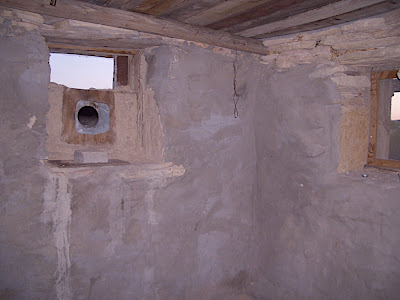
The back walls were well mortared, but the highest points hadn't been touched.
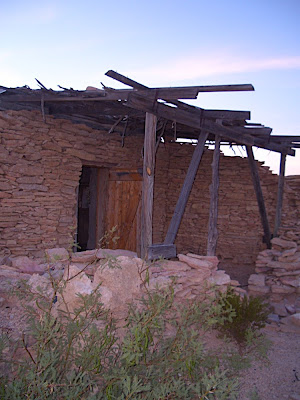
The awning? Made of rows of yucca stalks. Construction materials on hand are often enough well suited for the region. Perhaps it's a lesson we still haven't learned very well.
What's so great about the ruins is that you can see what different construction techniques were used. Above, the front blocks are a mixture of clay/dirt/hay bricks and they're clearly mortared with what looks like a similar mix. The wall behind it consists of stacked rocks. They're thin, flat pieces, so they're pretty stable. But there's no mortar. I'll try not to think of the number of spiders living in them...
Time has worn away the bricks, a shrub now inhabits an old room. The stacked walls remain.
One small building looked like it was still viable, so we investigated.
The walls on either side of the door were lightly mortared with concrete, but the process had been abandoned before completion.
The back walls were well mortared, but the highest points hadn't been touched.
The awning? Made of rows of yucca stalks. Construction materials on hand are often enough well suited for the region. Perhaps it's a lesson we still haven't learned very well.
dusty Terlingua
19 June 2010
Christmas Mountains
Our last morning of the trip was spent at the Christmas Mountains Oasis - a lovely bit of private property that is birder friendly upon request. We did not meet Carolyn, but we fell in love with the inhabitants we did come across.
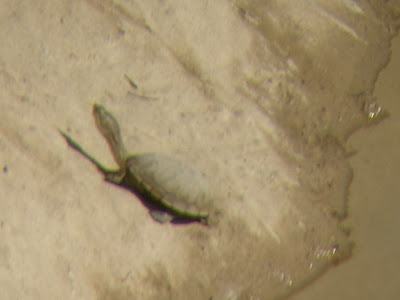
Of the two 'tanks' hosted a very long-necked cooter of some sort [a tank, in west Texas, is any depression, scrape, hole, container, pond, etc that can hold water].
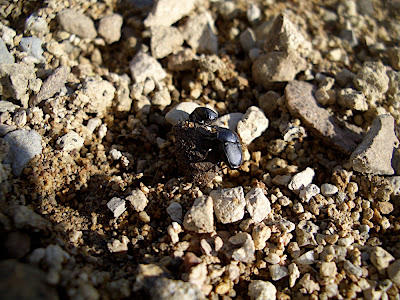
The path next to the parking area hosted two of the smallest dung-rolling creatures I've ever seen. They were easily half the size of the dung beetles we usually find. Very shiny little fellows, not making much progress while I watched. For scale, the ball they were trying to roll was roughly dime sized.

The desert scrub hosted a good number of singing Rufous-crowned Sparrows (Aimophila ruficeps), like the male in the photo above, as well as Black-throated Sparrows. The songs were faintly wafting up from all around, giving the property an ethereal break from silence. The occasional croak of Common Raven demanded attention, but otherwise the rhythms of summer heat were all that we heard. * there will be a cicada post eventually
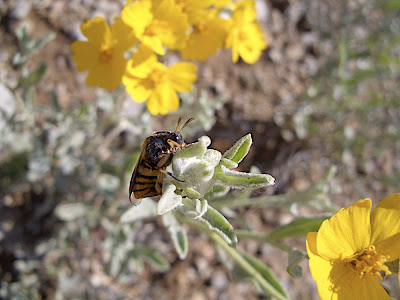
Insect life on the property was abundant. I think we ended our visit with over a dozen species of butterflies alone. Desert plants in bloom are magnets.

Lesser Nighthawks (Chordeiles acutipennis) were the expected nighthawks for the area and the early morning acrobats were skimming low above the vegetation... except for the unfortunate creature above. One guess is that it went down in the hail storm from the previous day. Another guess is that it was already there, based on the amount of debris that had settled on the submerged feathers (by the time we left, the carcass sank, lending support to the hail theory). Unfortunately, it was never close enough to fish out for further inspection - and as much as I've fished dead things out of sewage ponds and everything else, this just never got close enough for an attempt.

I hadn't expected to get this shot of an adult male Western Tanager (Piranga ludoviciana), but it turned out far better than the 3-pixel butt blur of Varied Bunting that will not be posted. Ah well, the mulberry trees were full of berries and being feasted upon by at least 5 different Western Tanagers.

Our new love: Western Black-necked Garter Snake (Thamnophis cyrtopsis collaris). There were at least 3 individuals seen, but no stellar photos beyond the one from Matt's earlier post.

...the view, graciously shared, of beautiful wilderness.
Of the two 'tanks' hosted a very long-necked cooter of some sort [a tank, in west Texas, is any depression, scrape, hole, container, pond, etc that can hold water].
The path next to the parking area hosted two of the smallest dung-rolling creatures I've ever seen. They were easily half the size of the dung beetles we usually find. Very shiny little fellows, not making much progress while I watched. For scale, the ball they were trying to roll was roughly dime sized.

The desert scrub hosted a good number of singing Rufous-crowned Sparrows (Aimophila ruficeps), like the male in the photo above, as well as Black-throated Sparrows. The songs were faintly wafting up from all around, giving the property an ethereal break from silence. The occasional croak of Common Raven demanded attention, but otherwise the rhythms of summer heat were all that we heard. * there will be a cicada post eventually
Insect life on the property was abundant. I think we ended our visit with over a dozen species of butterflies alone. Desert plants in bloom are magnets.

Lesser Nighthawks (Chordeiles acutipennis) were the expected nighthawks for the area and the early morning acrobats were skimming low above the vegetation... except for the unfortunate creature above. One guess is that it went down in the hail storm from the previous day. Another guess is that it was already there, based on the amount of debris that had settled on the submerged feathers (by the time we left, the carcass sank, lending support to the hail theory). Unfortunately, it was never close enough to fish out for further inspection - and as much as I've fished dead things out of sewage ponds and everything else, this just never got close enough for an attempt.

I hadn't expected to get this shot of an adult male Western Tanager (Piranga ludoviciana), but it turned out far better than the 3-pixel butt blur of Varied Bunting that will not be posted. Ah well, the mulberry trees were full of berries and being feasted upon by at least 5 different Western Tanagers.

Our new love: Western Black-necked Garter Snake (Thamnophis cyrtopsis collaris). There were at least 3 individuals seen, but no stellar photos beyond the one from Matt's earlier post.

...the view, graciously shared, of beautiful wilderness.
Subscribe to:
Posts (Atom)
















